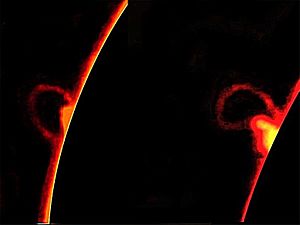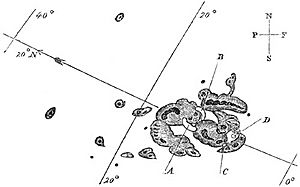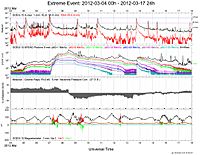Solar flare facts for kids
A solar flare is a sudden, bright flash seen on the Sun's surface. It's a huge burst of energy, like 160 billion tons of TNT exploding! This energy release can be compared to the impact of Comet Shoemaker–Levy 9 with Jupiter.
Often, a solar flare is followed by a giant cloud of solar material called a CME. These flares send clouds of tiny particles like electrons and ions from the Sun's outer atmosphere, called the corona, into space. These clouds usually reach Earth a day or two later. Solar flares are similar to "stellar flares" seen on other stars.
Solar flares affect all parts of the Sun's atmosphere, including the photosphere, chromosphere, and corona. They create radiation across the entire electromagnetic spectrum, from radio waves to gamma rays. Most of this energy is in wavelengths our eyes can't see. Special tools are needed to observe solar flares.
Flares happen in active areas around sunspots. They are powered by the sudden release of magnetic energy stored in the corona. The same energy bursts can also cause CMEs, but scientists are still learning how flares and CMEs are connected.
X-rays and UV radiation from solar flares can affect Earth's ionosphere. This can temporarily disrupt radio communications, radars, and other devices. Richard Christopher Carrington was the first person to see a solar flare in 1859. He noticed bright spots within a sunspot group. Solar flares can be very active, with several happening daily, or quiet, with only a few each week. Their activity changes during the 11-year solar cycle. Large flares are less common than smaller ones.
Contents
What Causes Solar Flares?
Flares happen when fast-moving charged particles, mostly electrons, interact with the Sun's plasma. Scientists think that a process called magnetic reconnection causes these particles to speed up so much.
On the Sun, magnetic reconnection can occur in solar arcades. These are groups of magnetic loops. The magnetic lines of force quickly reconnect into new loops, leaving some magnetic fields disconnected. The sudden release of energy during this reconnection makes the particles accelerate. The disconnected magnetic field and the material it holds can then burst outwards, forming a coronal mass ejection. This explains why solar flares usually erupt from active regions on the Sun where magnetic fields are very strong.
Even though scientists generally agree on where a flare's energy comes from, they don't fully understand how it works. It's not clear how magnetic energy turns into the movement energy of particles. Also, it's a mystery how some particles can speed up to incredibly high energies. Scientists are still unable to predict exactly when flares will happen.
How Solar Flares Affect Earth
Effects on Earth
X-rays and extreme ultraviolet radiation from solar flares are absorbed by the daylight side of Earth's atmosphere. They do not reach the Earth's surface, so solar flares are not a direct danger to people on Earth. However, this absorption of high-energy radiation can temporarily increase the ionization of the upper atmosphere. This can interfere with short-wave radio communication. It can also temporarily heat and expand Earth's outer atmosphere. This expansion can increase drag on satellites in low Earth orbit, which might cause them to slowly fall out of orbit over time.
Radio Blackouts
The temporary increase in ionization on the daylight side of Earth's atmosphere, especially in the D layer of the ionosphere, can disrupt short-wave radio communications. These communications rely on the ionosphere to reflect or bend radio waves. When ionization is higher than normal, radio waves can be weakened or completely absorbed. This happens because they lose energy from hitting more free electrons.
The strength of a radio blackout depends on how strong the solar flare's soft X-ray radiation is. The NOAA classifies radio blackouts based on the peak soft X-ray intensity of the flare.
| Classification | Associated Solar Flare | Description |
|---|---|---|
| R1 | M1 | Minor radio blackout |
| R2 | M5 | Moderate radio blackout |
| R3 | X1 | Strong radio blackout |
| R4 | X10 | Severe radio blackout |
| R5 | X20 | Extreme radio blackout |
Magnetic Crochets
Large solar flares cause more ionization in the D and E layers of the ionosphere. This increases how well these layers conduct electricity, allowing electric currents to flow. These currents in the ionosphere create a magnetic field that can be measured by tools on the ground called magnetometers. This event is known as a magnetic crochet or solar flare effect (SFE). It's called a "crochet" because of how it looks on magnetometer readings. These magnetic changes are very small compared to those caused by geomagnetic storms.
Effects in Space
For astronauts in low Earth orbit, the radiation dose from a solar flare's electromagnetic radiation is about 0.05 gray. This amount is not immediately deadly. However, a bigger concern for astronauts is the particle radiation that comes with solar particle events.
How We Observe Solar Flares
Flares produce radiation across the whole electromagnetic spectrum, but with different strengths. They are not very bright in visible light. However, they can be very bright at specific spectral lines. They usually produce X-rays and radio waves.
History of Observations
Looking with Telescopes
Solar flares were first seen by Richard Christopher Carrington and Richard Hodgson independently on September 1, 1859. They used an optical telescope with a special filter to project the Sun's image. This was an extremely strong white light flare, meaning it gave off a lot of light we could see.
Flares produce a lot of radiation at a specific wavelength called H-alpha. By adding a narrow filter (about 1 Å) centered at this wavelength to an optical telescope, even less bright flares can be seen with small telescopes. For many years, H-alpha was the main way to get information about solar flares. Other filters are also used today.
Listening with Radio Telescopes
During World War II, in February 1942, British radar operators noticed radiation that Stanley Hey realized was coming from the Sun. This discovery was kept secret until the war ended. In the same year, Southworth also observed the Sun using radio waves. His findings were also not known until after 1945. In 1943, Grote Reber was the first to publicly report radio observations of the Sun at 160 MHz. The fast growth of radioastronomy showed new features of solar activity, like "storms" and "bursts" related to flares. Today, radio telescopes on the ground observe the Sun from about 15 MHz up to 400 GHz.
Space Telescopes
Earth's atmosphere absorbs much of the Sun's electromagnetic radiation with wavelengths shorter than 300 nanometers. Because of this, space-based telescopes allowed scientists to see solar flares in high-energy wavelengths that were previously hidden. Since the 1970s, the GOES satellites have been constantly watching the Sun in soft X-rays. Their observations have become the main way to measure flares. Space telescopes also allow us to observe extremely long wavelengths, as long as a few kilometers, which cannot travel through the ionosphere.
Examples of Large Solar Flares
The most powerful flare ever observed is believed to be the one linked to the 1859 Carrington Event. No soft X-ray measurements were taken then. However, the magnetic crochet caused by the flare was recorded by ground-based magnetometers. This allowed scientists to estimate the flare's strength later. Based on these readings, its soft X-ray class is thought to have been greater than X10, possibly around X50.
In modern times, the largest solar flare measured with instruments happened on November 4, 2003. This event was so strong that it overloaded the GOES detectors, so its classification is only an estimate. At first, it was estimated to be X28. Later studies of its effects on the ionosphere suggested it might have been as strong as X45. This event also showed the first clear evidence of a new type of radiation above 100 GHz.
Other large solar flares have occurred on April 2, 2001 (X20+), October 28, 2003 (X17.2+ and 10), September 7, 2005 (X17), August 9, 2011 (X6.9), March 7, 2012 (X5.4), and September 6, 2017 (X9.3).
Predicting Solar Flares
Current ways to predict flares are difficult. There is no sure sign that an active region on the Sun will produce a flare. However, many features of sunspots and active regions are linked to flaring. For example, magnetically complex regions, called delta spots, produce the largest flares. A simple system for classifying sunspots is often used to help predict flares.
Predictions usually state the chances of M- or X-class flares happening within 24 or 48 hours. The U.S. National Oceanic and Atmospheric Administration (NOAA) provides these forecasts. A system called MAG4 was created to help forecast M- and X-class flares, CMEs, fast CMEs, and Solar Energetic Particle events. Scientists are also developing new physics-based methods to predict large solar flares.
Images for kids
-
An X5.4-class solar flare causing bright streaks in the image from the Solar Dynamics Observatory on March 6, 2012.
See also
 In Spanish: Erupción solar para niños
In Spanish: Erupción solar para niños






